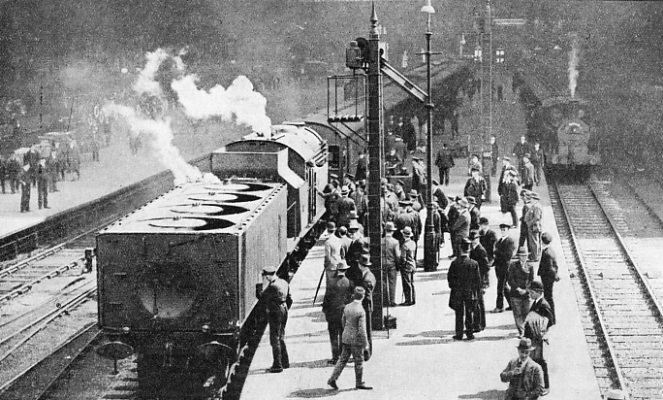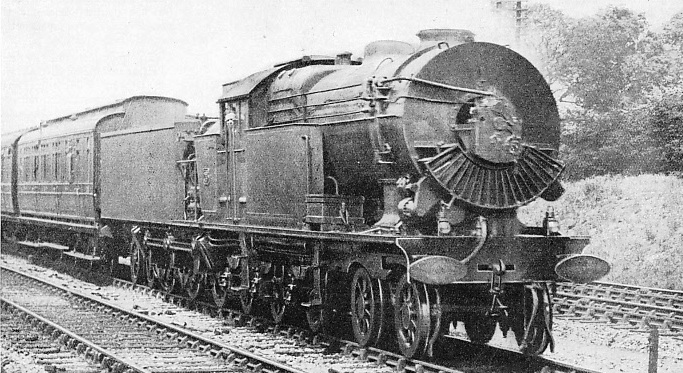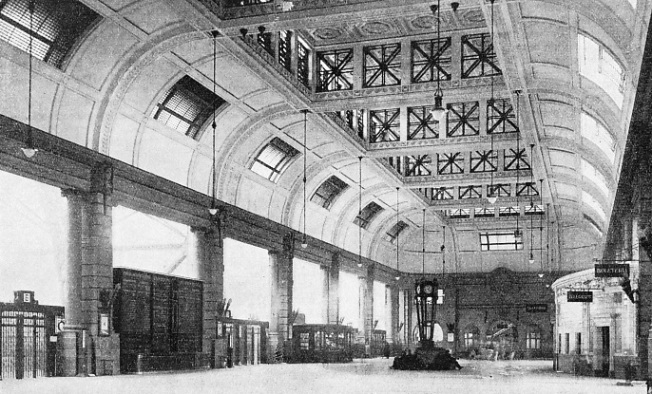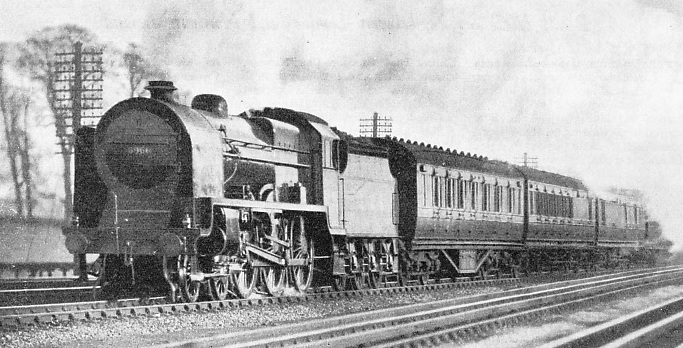
© Railway Wonders of the World 2012-


Part 44


Part 44 of Railway Wonders of the World was published on Friday 29th November 1935.
This issue contained a photogravure supplement on Alpine Ascents, which formed part of an article with the same title. The supplement appeared on pages 1395-1398
The Cover
This week’s cover depicts a French “Super-Pacific” locomotive in service on the Northern Railway of France. These compound engines have four cylinders and weigh, without tender, 96 tons. They haul some of the fastest french expresses, including the “Golden Arrow”, on their non-stop journey between Calais and Paris.
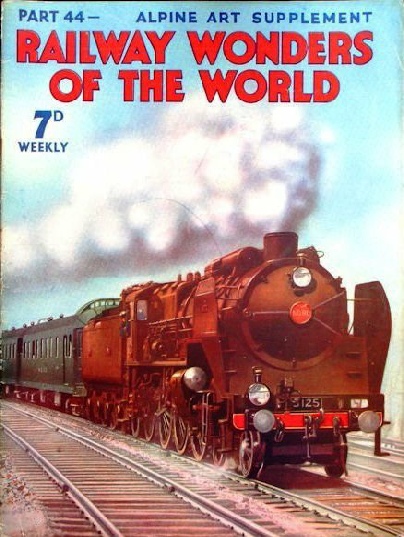
The Grand Hall of the Retiro Terminus
THE GRAND HALL of the Retiro Terminus of the Central Argentine Railway at Buenos Aires. This Grand Hall or concourse is 480 ft in length, 82 ft in width, and 63 ft in height. Of lofty and spacious design the station buildings at Retiro rank among the best in the world.
(Page 1383)
The “Ulster Express”
The important LMS boat train - the “Ulster Express” - runs every day, including Sundays. From Mondays to Fridays it leaves Euston at 6.10pm, reaching Heysham, Lancashire, a distance of 239 miles, at 10.52pm, where it connects with a steamer for Belfast, Ireland. The first 158 miles out of the London terminus to Crewe are covered at an average speed of 56.8 miles an hour. The “Ulster Express” is always composed of some of the finest modern rolling stock in Great Britain, including a special lounge car. The express frequently weighs well over 400 tons, and is generally hauled by a famous “Royal Scot” class express locomotive. The journey will be described in detail as an intent spectator, complete with stop-watch, has observed it. In response to many requests for particulars of the “Ulster Express”, a representative of Railway Wonders of the World travelled especially on it. The line cuts through the heart of England and taps one of the most active manufacturing areas. Between Crewe and Preston the express runs through the industrial region of Lancashire. Beyond Lancaster the north-west coast of England is approached and the seas is reached at Heysham, where the ship waits for the night crossing of the Irish Channel. The reference to the “special representative” strongly suggests this article was written by Cecil J. Allen. This is the fourteenth article in the series on Famous Trains.
(Pages 1385-1393 )
The “Ulster Express” Near Watford
NEARING WATFORD, HERTS, 17½ miles from Euston. The “passing time” of the “Ulster Express” at Watford is twenty-three minutes. The 4-6-0 engine illustrated is one of the “Baby Scots”. In the foreground are the suburban electric lines which accompany the main line as far as Bushey (16 miles), where they diverge to serve Watford High Street Station, rejoining the main line at Watford Junction, where they end.
(Page 1386)
Argentinean Locomotives
(Top) “MIKADO” ENGINE series 3001/8 for operation on the Buenos Aires and Pacific Railway. The engine weighs 102½ tons when empty, and 114½ tons in working order. The tender holds 7,700 gallons of water and 15 tons of coal, and weighs, in working order, some 86½ tons. This
2-8-2 locomotive was built by Beyer Peacock and Co, and was put into regular service in 1929.
(Middle) A passenger engine used on the Buenos Aires and Pacific Railway. This 4-6-4 tank engine weighs 100½ tons in working order. It has a fuel capacity of 3,100 gallons of water and 5 tons of coal. The locomotive was built by R. Stephenson and Company and put into regular service in 1930. The Buenos Aires and Pacific Railway has some 600 engines in operation on its lines.
Wonderful Alpine
Ascents - 2
SOARING UPWARDS out of the Rhone Valley on the Martigny-Chatelard Railway . The gradient at the section in the above illustration is 1 in 5. Propulsion is by rack-and-pinion, and the line is electrically operated. It extends from Martigny to Vallorcine, on the French frontier, where it connects with a narrow-gauge branch of the PLM Railway leading to Chamonix in France.
(page 1396)
Wonderful Alpine
Ascents - 3
A BREATHLESS CLIMB, on a gradient of approximately 1 in 1½ on the Niesen Railway. This spectacular rope-worked or funicular line lifts the passenger through a difference of level of 5,479 ft in thirty-five minutes. The Niesen is a well-known viewpoint in the Bernese Oberland. The mountain rises in an almost perfect cone to a height of 7,762 ft above the lake of Thun.
(Page 1397)
Developments in South Africa
The South African Railways and harbours control over 13,000 miles of track. This chapter outlines the system as it is to-day, showing how the discovery of the country’s vast mineral resources has influenced the growth of transport. Although their gauge is a narrow one - mostly 3 ft 6 in - the South African Railways possess on their lines some of the world’s finest locomotives, up-to-date rolling stock, and some remarkable engineering works. The pioneers faced innumerable obstacles, and it is estimated that early lines in Natal, the Transvaal and the Orange Free State cost some £15,000 for every mile of track laid. This is the fourteenth article in the series Railways of the Empire.
(Pages 1404-1407 )
The Rand-Durban Luxury Express
THE RAND-DURBAN LUXURY EXPRESS. Trains from Johannesburg cover the 494 miles to the port of Durban in just over eighteen hours. The luxury expresses include articulated first-class saloons, dining-car, and observation car at the rear. The above train is hauled by a 4-8-2 or “Mountain” type South African locomotive.
(Page 1404)
Experimental Locomotives (Part 1)
There would seem to be no limit to locomotive progress. Engineers are never satisfied, and greater efficiency is demanded. This chapter describes some recent locomotive experiments. It includes and account of the famous Ljungstrom turbine engine, other notable turbine-driven locomotives, and locomotives built with abnormally high working pressures, both in Great Britain and other countries. The “Silver Link” of the LNER, which recently created new world records, will also be mentioned, but will be dealt with more fully in a following chapter. Mr Cecil J. Allen and I were privileged to travel on “The Silver Jubilee” on September 27 1935, when it created four world records. The article is the sixteenth in the series on Design and Invention. The article concludes in part 45.
(Pages 1408-1412 )
The First Ljungstrom Turbine Locomotive
Invented by a Swedish engineer, it was built in 1921, and achieved some success on the Swedish lines. A similar engine was built in 1924 in Britain, and this locomotive covered 5,402 miles during some months service on the LMS. Transmission from the turbine to driving axles was by triple gearing. At 75 miles and hour, the turbine made 10,500 revolutions a minute, and the maximum tractive effort was 40,320 lb. The locomotive is seen here at St Pancras Station.
(Page 1408)
Wonderful Alpine Ascents
Switzerland is one of the world’s most spectacular countries. Its railways are equally spectacular. Mr Cecil J. Allen contributes this chapter on this fascinating subject. The article is concerned with one or two of the smaller and more unfamiliar but not less interesting lines. These include the Chur-Arosa Railway , the Martigny-Chatelard Railway - a line for which over a mile has a gradient of 1 in 5, the Visp-Zermatt Railway , and the Gornergrat Railway. The upper terminus of the Gornergrat Railway lies 10,235 ft above sea-level. Though not attaining the height of the Jungfrau line, the Gornergrat Railway is notable because it is in the open air practically throughout its steep route. An amazing cable-operated railway has a line up the Niesen Mountain. On this line a difference in level of practically 5,500 ft is conquered in thirty-five minutes, while the maximum steepness is approximately 1 in 1½. The latter part of the chapter deals with the suspension railways of the Alps, known locally as telepheriques. They have been constructed of late years up the mountains round the well-known French pleasure resort of Chamonix. The latest project plans to carry the traveller 12,610 ft above sea-level. (Pages 1394-1403 )
Wonderful Alpine Ascents: Photogravure Supplement
FINDELEN VIADUCT carries the Gornergrat Railway above the Findelenbach Gorge. The bridge is a cantilever structure, with its arch hinged in the centre. The beautiful waterfall seen in the background is the overflow from the hydro-electric power station supplying the railway with current.
(Page 1395)
Wonderful Alpine
Ascents - 4
(Top) EIGER, MONCH AND JUNFRAU, the trio of giant peaks of the Bernese Oberland, are best viewed from the Schynige Platte, to which the rack-and-pinion electric train in the foreground is ascending. The steepest gradient on this line is 1 in 4, and the total ascent is
4,540 ft.
(Bottom) A COLOSSAL ARCH OF 350 FT. SPAN across the Plessur Valley at Langweis, on the Chur-Arosa line. This is the largest ferro-concrete arch span of its kind in Europe. The railway that it carries 203 ft above the torrent serves the well-known resort of Arosa in the Grisons, 5,715 ft above sea-level.
(Page 1398)
Contents of Part 44
By Rail in the Argentine (Part 2)
The “Ulster Express”
Wonderful Alpine Ascents
Wonderful Alpine Ascents (photogravure supplement)
Developments in South Africa
Experimental Locomotives (Part 1)
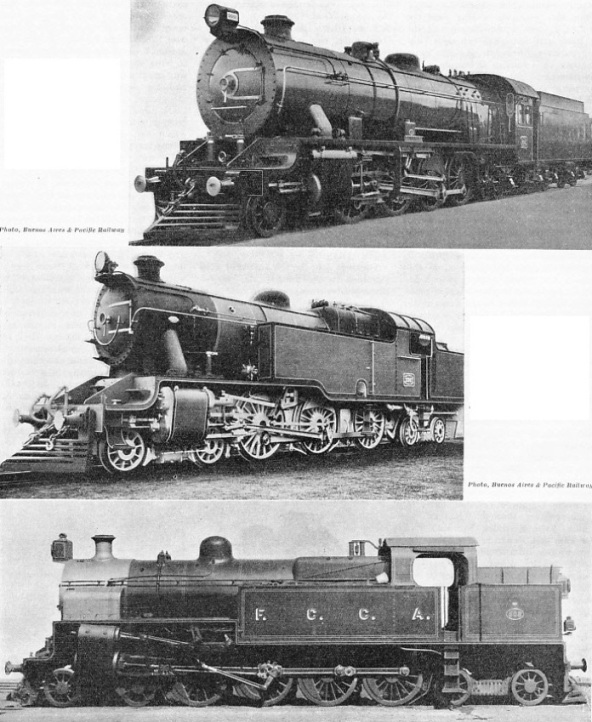
(Bottom) 4-8-4 tank engine in operation on the Central Argentine Railway, for hauling passenger and heavy goods trains. The Central Argentine Railway possesses some 670 modern locomotives, and the average load on this system behind a freight engine is about 870 tons. The corresponding figure for a passenger train is about 280 tons.
(Page 1382)
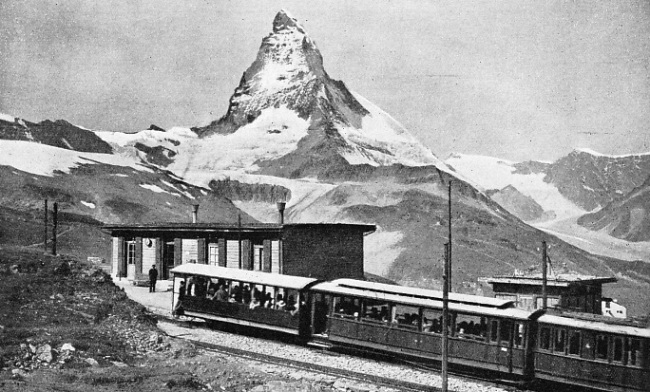
Riffelberg Station on the Gornergrat Railway
THE GIANT MATTERHORN forms a striking background to the Gornergrat railway at the Riffelberg Station, 8,430 ft above sea-level. Between the railway and the mountain is the vast depth of the Gorner Gorge. All the smaller glaciers of the Matterhorn and Monte Rosa merge to form the great glacier in this gorge.
(Page 1394)
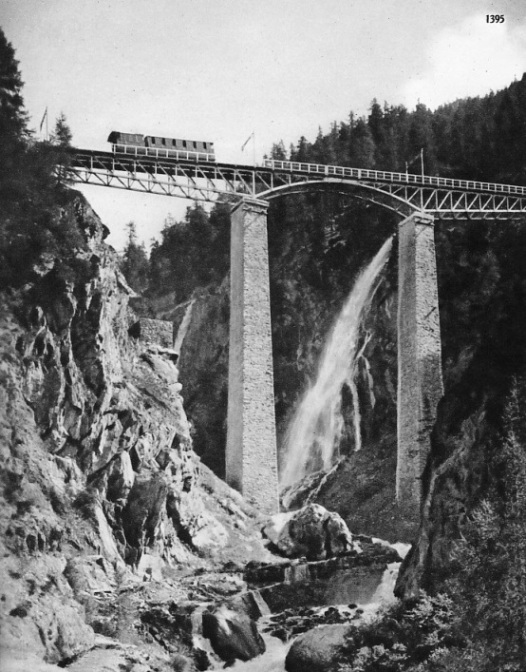
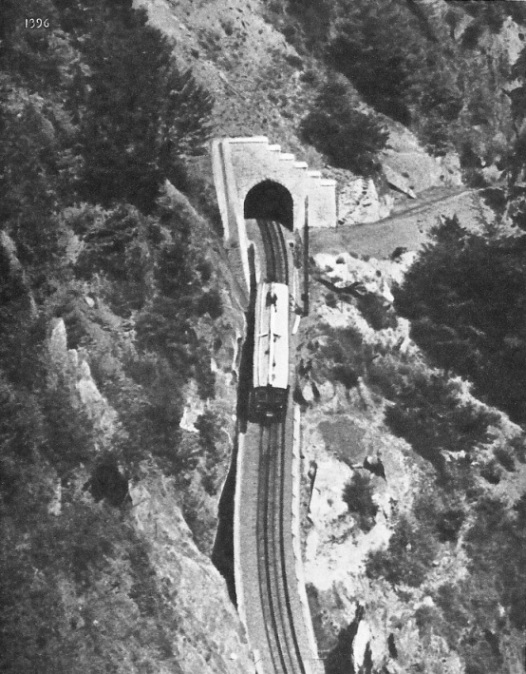
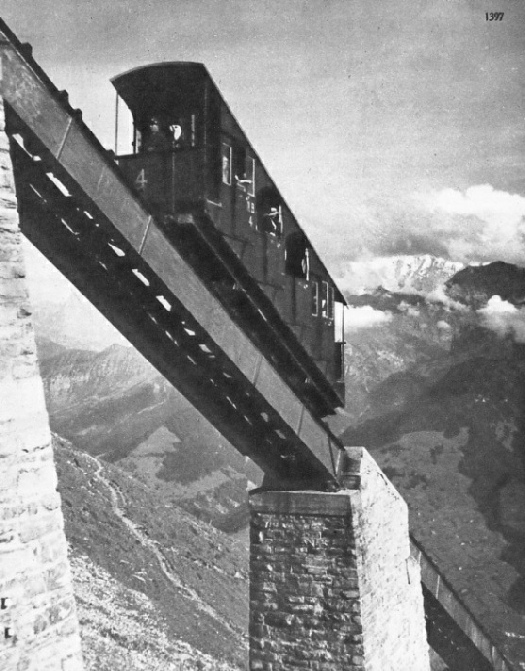
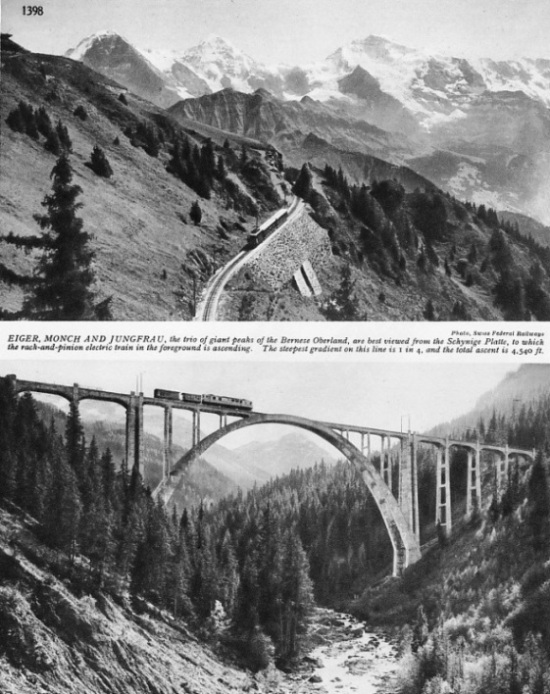
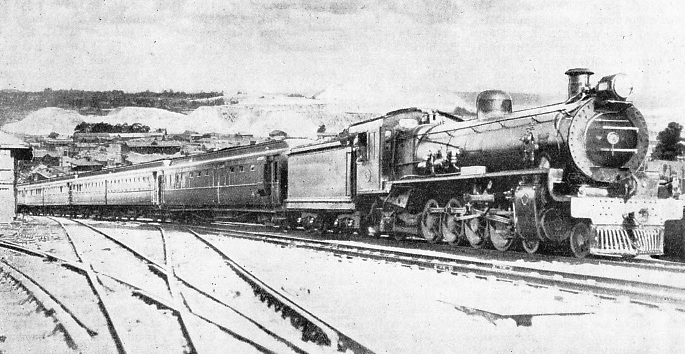
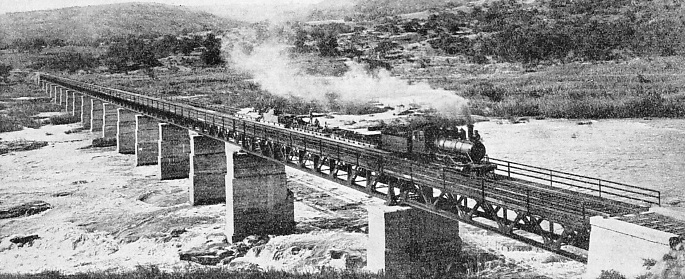
Across the Tugela River
ACROSS THE TUGELA RIVER in Northern Natal, a seventeen-span steel and concrete structure carries the railway. In the above illustration a local freight can be seen passing over the bridge.
(Page 1407)
The 1926 Turbine Engine on the LMS
STEAM WAS GENERATED at the pressure of 300 lb per sq in in the 1926 turbine engine, tried out on the LMS. The locomotive successfully worked express services on the Midland Division of the railway. The engine weighed 143¾ tons in working order, and proved efficient in operation but though economies were effected they did not lead to the construction of other engines of this type.
(Page 1412)
